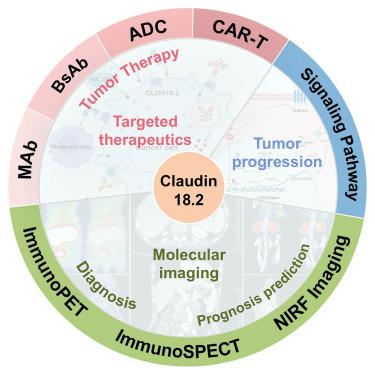Targeting Claudin18.2 for cancer theranostics: From molecular imaging to precision therapy
IF 4.1
2区 综合性期刊
Q1 MULTIDISCIPLINARY SCIENCES
引用次数: 0
Abstract
Claudin18.2 (CLDN18.2), a specific tight junction protein isoform, is minimally expressed in normal gastric mucosa but aberrantly overexpressed in various cancers. It plays a key role in regulating tumor cell differentiation, proliferation, and migration, making it an attractive therapeutic target, especially in gastric cancer. Moreover, molecular imaging techniques such as immuno-positron emission tomography, immuno-single photon emission computed tomography, and near-infrared fluorescence imaging enable non-invasive evaluation of CLDN18.2 expression, improving diagnosis and guiding personalized treatment. This review summarizes recent advances in CLDN18.2-targeted therapies and molecular imaging for cancer management. We outline the biomarker’s biological functions and signaling pathways across cancers, highlighting the development of precision therapeutics. We also discuss applications and limitations of CLDN18.2-targeted theranostics in digestive malignancies and address clinical translation challenges and future directions.

靶向Claudin18.2用于癌症治疗:从分子成像到精确治疗
CLDN18.2 (CLDN18.2)是一种特异性紧密连接蛋白亚型,在正常胃粘膜中表达极低,但在各种癌症中异常过表达。它在调节肿瘤细胞分化、增殖和迁移中起着关键作用,使其成为一个有吸引力的治疗靶点,特别是在胃癌中。此外,分子成像技术,如免疫-正电子发射断层扫描、免疫-单光子发射计算机断层扫描和近红外荧光成像,可以无创地评估CLDN18.2的表达,提高诊断水平,指导个性化治疗。本文综述了cldn18.2靶向治疗和分子成像在癌症治疗中的最新进展。我们概述了生物标志物在癌症中的生物学功能和信号通路,强调了精确治疗的发展。我们还讨论了cldn18.2靶向治疗在消化道恶性肿瘤中的应用和局限性,并讨论了临床翻译的挑战和未来的发展方向。
本文章由计算机程序翻译,如有差异,请以英文原文为准。
求助全文
约1分钟内获得全文
求助全文
来源期刊

iScience
Multidisciplinary-Multidisciplinary
CiteScore
7.20
自引率
1.70%
发文量
1972
审稿时长
6 weeks
期刊介绍:
Science has many big remaining questions. To address them, we will need to work collaboratively and across disciplines. The goal of iScience is to help fuel that type of interdisciplinary thinking. iScience is a new open-access journal from Cell Press that provides a platform for original research in the life, physical, and earth sciences. The primary criterion for publication in iScience is a significant contribution to a relevant field combined with robust results and underlying methodology. The advances appearing in iScience include both fundamental and applied investigations across this interdisciplinary range of topic areas. To support transparency in scientific investigation, we are happy to consider replication studies and papers that describe negative results.
We know you want your work to be published quickly and to be widely visible within your community and beyond. With the strong international reputation of Cell Press behind it, publication in iScience will help your work garner the attention and recognition it merits. Like all Cell Press journals, iScience prioritizes rapid publication. Our editorial team pays special attention to high-quality author service and to efficient, clear-cut decisions based on the information available within the manuscript. iScience taps into the expertise across Cell Press journals and selected partners to inform our editorial decisions and help publish your science in a timely and seamless way.
 求助内容:
求助内容: 应助结果提醒方式:
应助结果提醒方式:


